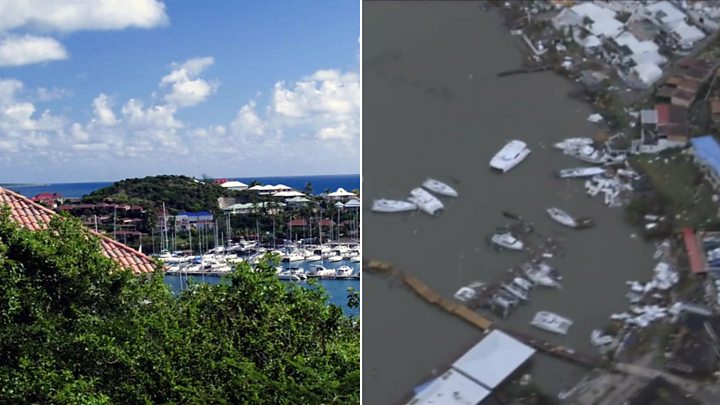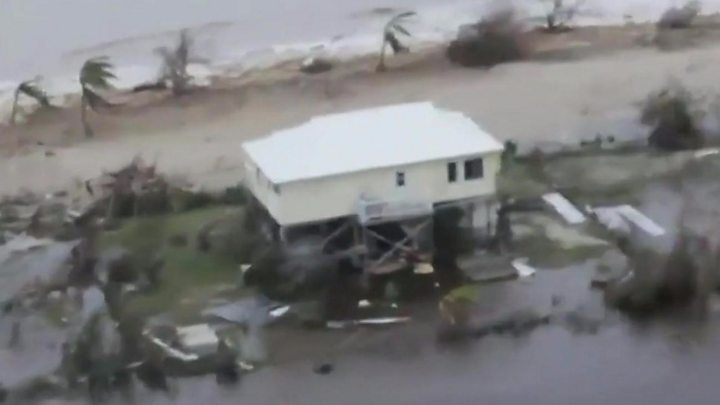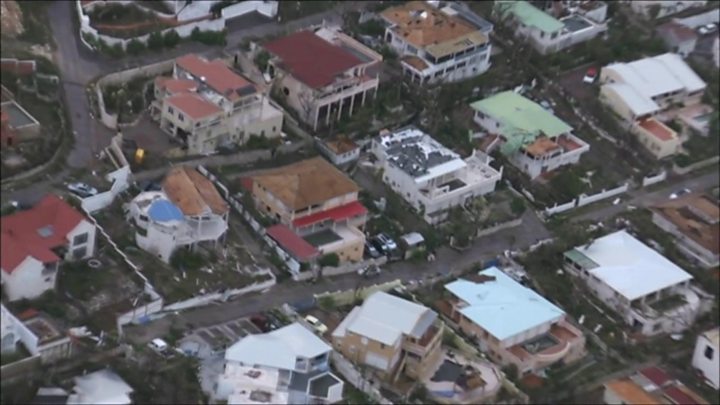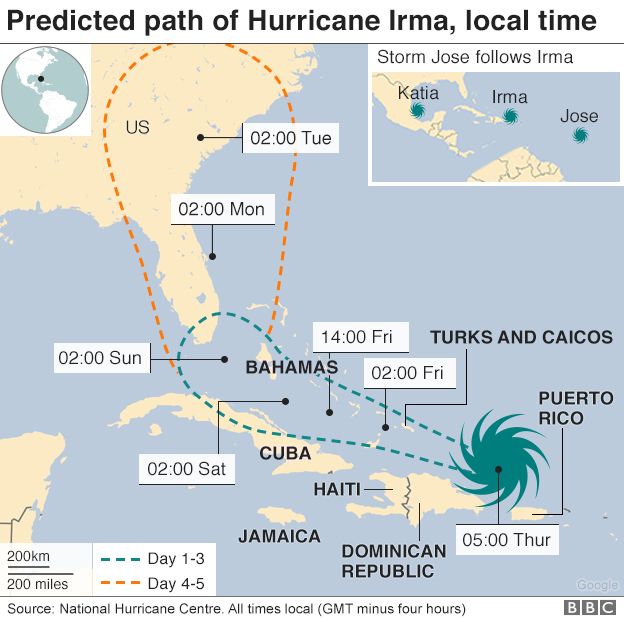Hurricane Irma bears down on Turks and Caicos islands
The low-lying Turks and Caicos islands are preparing for the arrival of Hurricane Irma, which has left a trail of destruction across the Caribbean.
The British overseas territory is said to be at risk of a storm surge, with the possibility of destructive waves up to 6m (20ft) higher than usual.
Irma is a category five hurricane, the highest possible level.
Islands in its path have seen winds of about 180mph (285km/h). At least 10 people have died.
The small island of Barbuda is said to be "barely habitable". Officials warn that St Martin is almost destroyed, and the death toll is likely to rise.
Irma is currently north of the Dominican Republic, heading towards the Turks and Caicos and is expected to hit the chain on Thursday evening.
It is expected to reach Cuba next before hitting the US state of Florida at the weekend, with the head of the US emergency agency predicting a "truly devastating" impact.
An estimated 1.2 million people have been affected by Irma, a number that could rise sharply to 26 million, the Red Cross says.
"Our worst fears have played out in Barbuda and elsewhere," Walter Cotte, Americas director for the International Federation of Red Cross and Red Crescent Societies, said in a statement.
There are concerns that disease could spread rapidly in areas where drinking water and sanitation services have broken down.

Preparations for the arrival of Irma are well under way on the Turks and Caicos, which has a population of about 35,000. Its highest point is only 50m (163ft).
Governor John Freeman said: "We have decided to evacuate certain islands which were particularly low-lying and at threat. We have started to fill our shelters because a number of people who live in very low-lying areas are very vulnerable.
"We've also engaged in terms of getting people off the island who are here, North American tourists and others. "
Virginia Clerveaux, director of the Turks and Caicos Department of Disaster Management and Emergencies, told the BBC that even inland areas could be inundated by the storm surge.
"We are now trying to remind them [the people of the islands] that this is a category five, and in the history of the Turks and Caicos islands this is the largest storm we have ever been impacted or threatened by.
"So there is a need to ensure that we have maximum preparations in place... We have been saying to persons to ensure that they are prepared, ensure they can shelter safely, they have sufficient food and drinking water for two to three days."

Britain, France, and the Netherlands and Britain have sent ships, rescue teams and emergency supplies to their territories that have been hit by Hurricane Irma.
Aid efforts are being hampered by damage to local airports and harbours.
What are the worst-hit areas?
Hurricane Irma first struck the dual-island nation of Antigua and Barbuda. At least one death, of a child, was reported on Barbuda, where Prime Minister Gaston Browne said about 95% of the buildings had suffered some damage.
"It's absolute devastation," he said after flying over the island, home to some 1,600 people. "The island is literally under water. In fact, I'm of the view that, as it stands now, Barbuda is barely habitable."
He told the BBC that 50% of the Barbuda population were now homeless and that it would cost $100m (£80m) to rebuild the island.
However, Antigua, with a population of 80,000, escaped major damage, with no loss of life.

St Martin, an island that comprises the French territory of Saint-Martin and the Dutch section Sint-Maarten, suffered terrible damage.
French officials have confirmed at least four deaths in Saint-Martin, down from an earlier reported death toll of eight. More than 50 people were injured. Dutch authorities reported one death and many injuries.
French Prime Minister Edouard Philippe said 60% of homes had been made uninhabitable.
Sint-Maarten's airport, the third largest in the Caribbean, has been seriously damaged.

At least three people had died in Puerto Rico, the governor's office said.
The US territory's capital, San Juan, saw waves of up to 30ft. More than 6,000 residents are in shelters, and many more are without power.
Where else has been hit?
British overseas territories Anguilla and the British Virgin Islands were also caught in the extreme weather.
At least one death has been reported on Anguilla, a local official confirmed.
One Anguilla resident told the BBC the island looked as if it had been struck by a nuclear bomb, with roofs torn off many of the main buildings, including the hospital.
What the US can expect
Irma is expected to hit Florida as a category four hurricane on Sunday, bringing storm surges and flooding.
"If you look at the size of this storm, it's huge," Florida Governor Rick Scott said on Thursday. "It's wider than our entire state and could cause major and life-threatening impacts on both coasts - coast to coast."
US President Donald Trump said: "I can say this: Florida is as well prepared as you can be for something like this. Now it's just a question of what happens.
"We have tremendous talent and really tremendously brave people to be there and hopefully it's going to work out all right.
"We are with the people of Florida."
Evacuations of tourists and residents of the Florida Keys, a resort archipelago, have begun.
Flights to and from airports in Florida are being suspended. Orlando's international airport said commercial flights would stop from 17:00 local time on Saturday.
Islands still at risk from Irma
Dominican Republic
- Population: 10.2 million
- Key facts: major tourist destination, shares island of Hispaniola with Haiti
- Hurricane prediction: Irma expected to pass close by
Haiti
- Population: 10.2 million
- Key facts: on the same island as the Dominican Republic; devastated by an earthquake in 2010
- Hurricane prediction: not directly in the hurricane's path, but remains on alert
Turks and Caicos
- Population: 31,500
- Key facts: enjoys one of the more dynamic economies in the region thanks to upmarket tourism, offshore finance and fishing
- Hurricane prediction: the low-lying region is at risk of a storm surge with destructive waves up to 6m (20ft) higher than usual possible
Cuba
- Population: 11 million
- Key facts: one of the world's last planned economies; a producer of sugar, tobacco and coffee, with a big tourism industry
- Hurricane prediction: Tropical storm conditions expected to begin on Thursday night (local time)
Bahamas
- Population: 350,000
- Key facts: an archipelago of more than 700 islands and islets, which attracts millions of tourists per year
- Hurricane prediction: warnings for north-west, south-east and centre; some areas have risk of storm surge of up to 6m (20ft)
Are there more hurricanes to come?
Another storm, Jose, further out in the Atlantic behind Irma, has swelled to category two hurricane strength and could be near major hurricane strength on Friday, according to the US National Hurricane Center.
Forecasters say Jose is expected to pass close to the Leeward islands, a collective name for islands from Dominica to Puerto Rico. Its exact path is as yet unclear but winds are not expected to be as strong. However, it may hit areas already devastated by Irma.
Storm Katia, in the Gulf of Mexico, was also upgraded to hurricane status, and a warning was in effect for the coast of the Mexican state of Veracruz.

Are you in the region? Are you a holidaymaker unable to get a flight home or a resident who has been preparing for Hurricane Irma? If it is safe for you to do so, share your experiences

Post a Comment